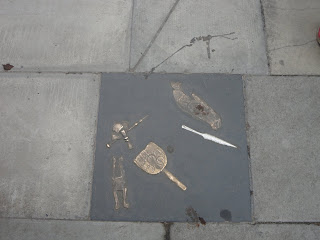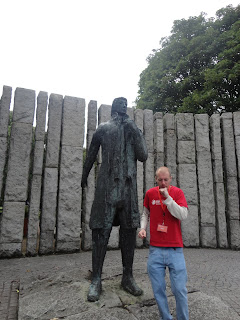 Dame Street. This is where we met for the tour.
Dame Street. This is where we met for the tour.  The only original part of the castle- the Records Tower. Right next to it, the chapel. The chapel was build during the 1700's.
The only original part of the castle- the Records Tower. Right next to it, the chapel. The chapel was build during the 1700's.  Dublin Castle Park. The place where Dublin got its name. From the Irish "dubh-linn", meaning black pool.
Dublin Castle Park. The place where Dublin got its name. From the Irish "dubh-linn", meaning black pool. I will admit that I am a nerd. So, when some people asked me today if I would like to go to the Docklands and enjoy a day of eating and just hanging out, I passed because I was going to do a walking tour of Dublin and get my history on. Seriously, nothing beats history.
To satisfied my history crave, I decided to go on a SANDEMANs New Europe walking tour. If anyone is traveling in Europe, they need to check this group out. What makes this group amazing is that the tours are free! That is right, no charge! And there are no hidden fees or what not. The only thing you pay is tipping. Since it is free, EVERYONE BETTER TIP! The tour guides only get paid with what tips they earn. And they do a great job and deserve tips!
What is even more amazing than it being free, is the fact that the tours are of a high quality.
My guide was named Peter and he was a class act. Peter knew all the information and he had a passion for it that you would see when he talked. Peter was the best.
The tour started with a 10 minute lecture on the history of Ireland. Thousands of years of history, condensed into 10 minutes. Epic.
The group was then taken to Dublin Castle. Now, when you think of castles in Ireland, you probably have this very romantic view of what they should look like. Dublin Castle is not really a castle. It was originally built in the 13th century, but a fire in 1684 destroyed almost all of the castle. So the castle looks like it is a building from the 1600's.
For years, Dublin Castle was a sign of English rule over Ireland. This is where the high authority in Ireland lived. These high authority personnel were suppose to bring justice to the people, but most of the time, justice turned its back to the Irish. The Irish were not blind to this.
The only original part of the castle is the Record Tower. This tower looks like it is from the 1200's. For most of its history, the Record Tower was actually a jail and kept some famous Irish rebels. It is when one of inmates escaped and returned home to his clan, that the 9 Year War started.
Next, Peter brought us over to the garden of the castle. The garden is very simple and very nice. It is in a circular shape with grass and these cement lines going every which way. Peter explained that these lines represented Celtic snakes.
The garden is very significant because it is in this location that Dublin got its name. Under the grass use to be a small pond that a river would dump into. The Vikings would come up the river and anchor their boats in this pond. Because of the pond was swallow, it looked like black water. The Irish for black pool is "dubh-linn". Over time, the Irish word has changed to Dublin.
Christchurch was the next stop on the tour. It was only a 10 minute walk from Dublin Castle. The church was built between 1172-1220. The appearance has changed over time, due to restoration work in the 1800's. Peter told us that the most popular attraction in the church is a stuffed mouse and cat. The story goes that while one of the maintenance workers was cleaning out the organ, he pulled out a dead cat. He put the cat aside and continued cleaning. Further up the same organ pipe, he found the mouse. He concluded that the mouse ran up the organ to escape the cat and got stuck. The cat chased the mouse and got stuck as well.
Right around the corner from Christchurch was a modern building built for the city council. This building has a tragic story. When building was beginning, they discovered some well preserved Viking artifacts as well as preserved Viking structures. Instead of keeping the artifacts and structures, the government continued with the buildings destroying the structures. Museums in Dublin tried to salvage as many artifacts as they could, but many were destroyed. People really need to get better priorities.
On a happier note, Peter lead us to Temple Bar and gave us a 30 minute lunch break. I packed a lunch, so I just went to the River Liffey and sat down. All great cities have a river.
After lunch, Peter gave us some history of Temple Bar. Today, Temple Bar is known as the cultural center of Dublin. Many artists and writers live in the area. It also has the reputation for being the place to go to for nightlife.
But Temple Bar did not always have this fun reputation. It is only during the 20th century that Temple Bar's cultural and nightlife reputation grew. Originally the area was owed by Sir William Temple. He had a garden and a walkway that people would use to walk along the river. Soon it came to be known as Temple Barr. A barr refers to a walkway along a river. Over time, the last "r" has been dropped and we now know it as Temple Bar.
We then walked to a group of buildings that has the National Library and the National Museum of Archaeology. The buildings also house the Irish Parliament. The Parliament was not always suppose to be in the building. They told the owner that they were just going to use it temporarily.... and then never left.
To conclude the tour, we stopped by St. Stephen's Green. What a beautiful park! Here, Peter told us how Ireland got its independence. He told us of Irish heroes. Right across the street is the Shelbourne Hotel, where the constitution of the Republic of Ireland was made.
The tour was amazing and I learned so much. Again, I highly recommend people take these tours when they are in Europe. It is a great way to spend an afternoon! :)
Go to http://www.neweuropetours.eu to learn more about the tours and what cities they are in!

















No comments:
Post a Comment